This is one of the most important questions for a new or soon-to-be RV owner. In the case of the Class A and Class C, you will not need a “towing” vehicle however, you should consider a vehicle to “tow!” This is a slightly less complicated process as you will want to look at the tow rating for your particular rig and ensure that the weight of the car (as seen in the driver’s side doorjamb) is below that tow capacity number.
Below we will explore the different factors to consider when purchasing a towing truck. This said, some of you may already have the truck that you will be using to tow the vehicle. In this case, you want to make sure you have an idea of what the legal capacities are of the truck as well as what you are comfortable towing (this is personal preference and can be highly varied from person to person). Some of the most important factors are:
- GVWR – Gross Vehicle Weight Rating
- Truck Payload
- Towing capacity (for your engine/transmission/differential combination)
- GCWR – Gross Combined Weight Rating
GVWR – Gross Vehicle Weight Rating
This is the maximum weight that your truck can weigh (including empty weight, passengers, cargo, hitch/pin weight, tool box, etc.)
Truck Payload
GVWR minus (-) empty weight of the truck. Manufacturers brochures can give a good starting point for comparison however, this number is unique to a particular vehicle as it is a number as weighed and includes options and other individual characteristics. Have you ever seen a truck like the one below? This is likely because they have exceeded their payload rating which has opened them up to legal liability, poor handling characteristics (especially in wet or windy conditions) and possible mechanical failure.
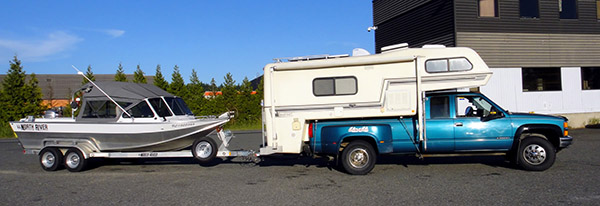
GCWR – Gross Combined Weight Rating
This is the maximum your truck plus (+) trailer can weigh. Normally, if you ensure the payload and towing capacity are within limits, you will not need much discussion here, but it is still your legal obligation to know this number.
Towing Capacity
This is one of the most publicized numbers among truck manufacturers. Pictures such as this one can be easy to understand but can also be VERY misleading. We will discuss this below…
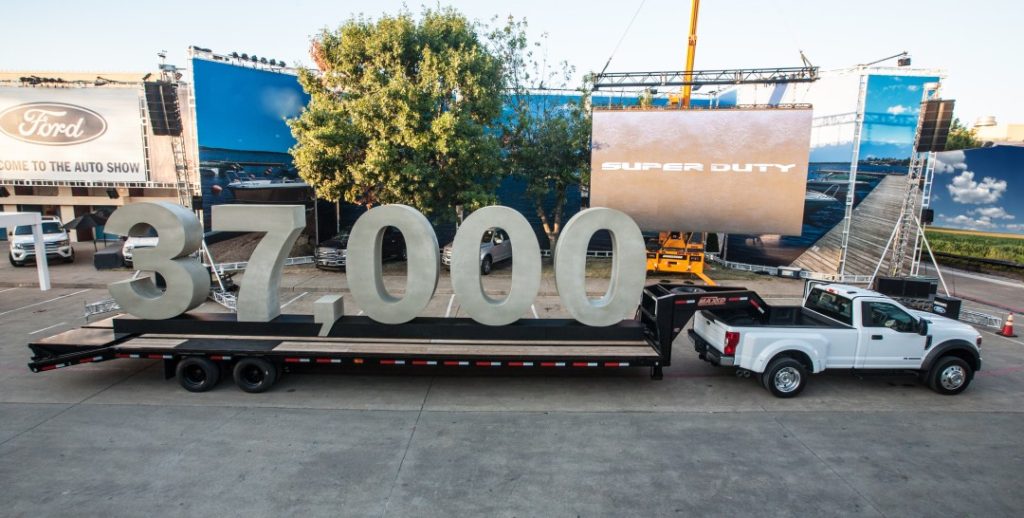
Let’s get to the details of the truck
For our example we will be using a mix of data from several sources, so be certain the check your specific model, year, and make for the most accurate information.
The general process of research across truck years, makes, models is the same as all manufacturers will publish their specs as tested under relatively equal situations (SAE J2807 compliant). Interested in knowing how? Here is a great Edmunds.com article on the testing specifics at Davis Dam in Arizona.

Payload
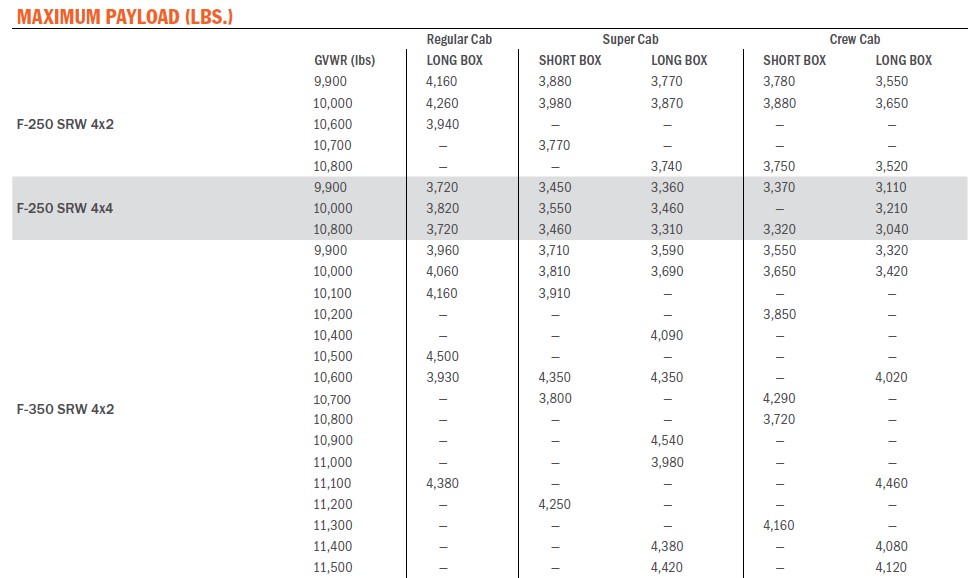
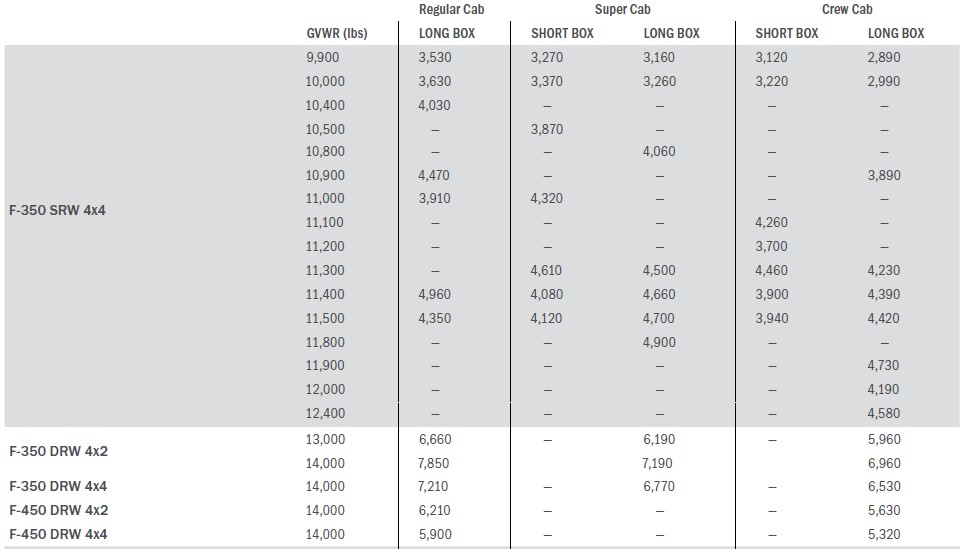
As you can see above, these charts can be numbers overload. Let’s take an example window sticker and break it down…
350 SRW (Single Rear Wheel) 4×4 – 160″ WB with the 11,5000 GVWR package

From the header of the sticker, we can determine a lot about the truck. If we look at the above chart, there area lot of numbers for the F350 SRW. The difference will be in the GVWR package, but what package does this one have? If you look under the “optional equipment” section of the WINDOW STICKER (be careful, online listings can be misleading and often inaccurate).
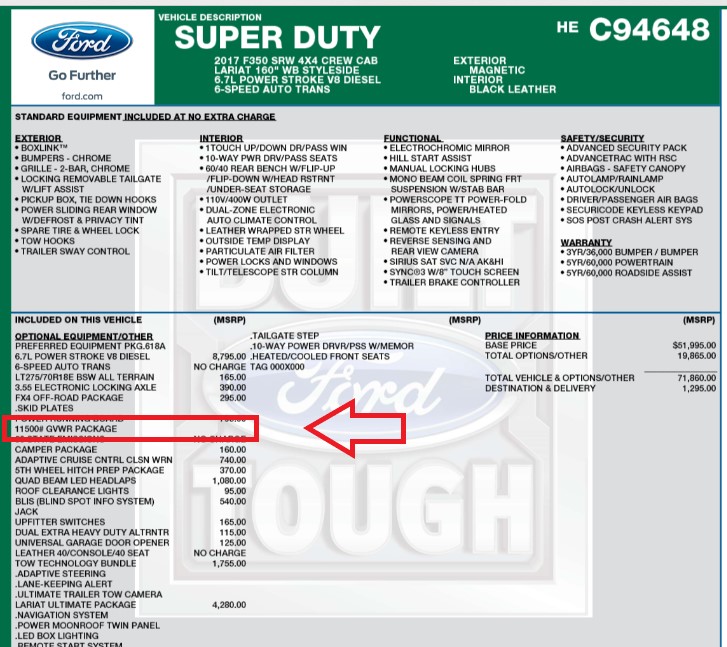
So let’s look at the spec sheet…
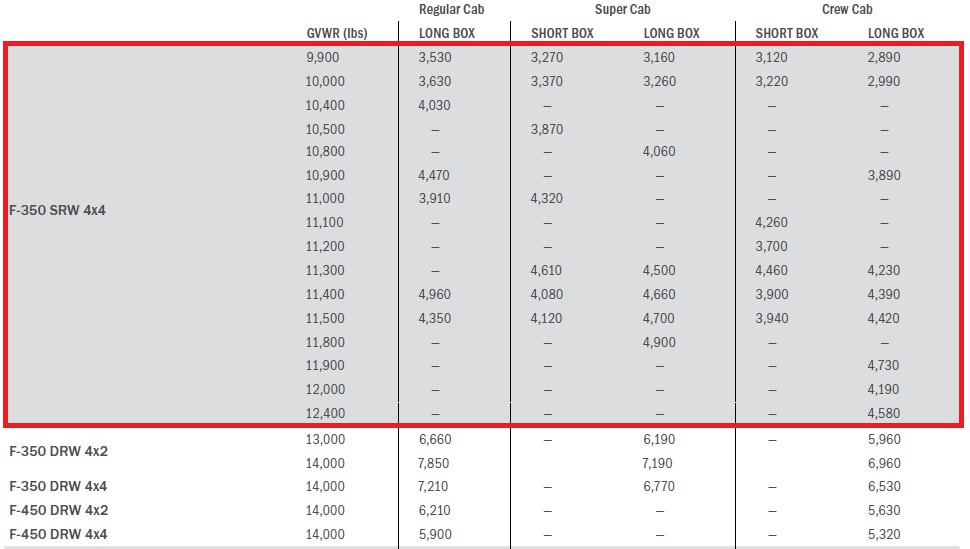
But do we have the “short box (SWB)” or the “long box (LWB)?” The answer lies just a little higher in the spec sheet under “Exterior dimensions” – the green header (from the above example) says ‘Crew Cab with 160″ WB.’ Looking at the exterior dimenions section of the spec sheet (pictured below), we determine this is a SWB or “short box.”

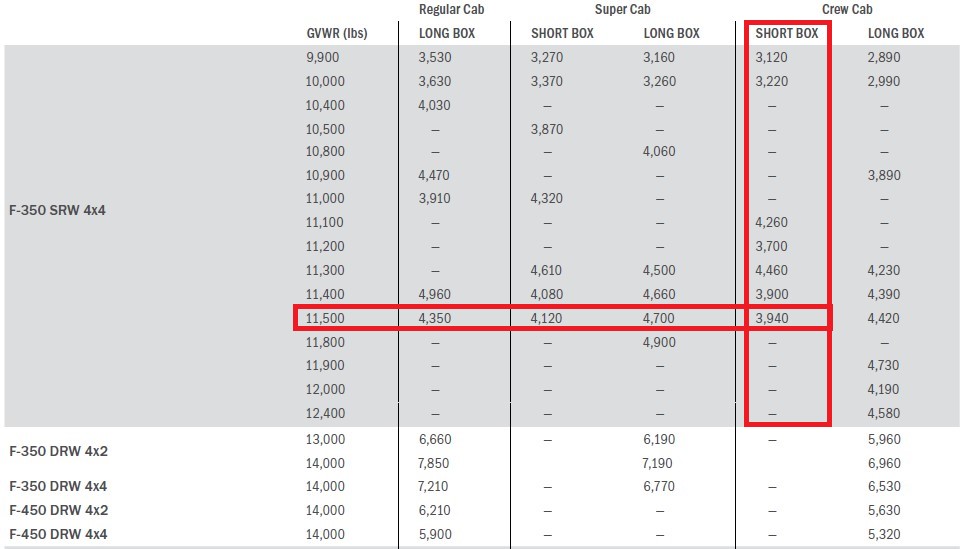
Where the two columns intersect is our payload – 3,940 pounds for this particular vehicle. This weight includes trailer tongue or pin weight, any passengers (driver is already assumed as is a full tank of fuel), tools in the truck, etc. Additionally, this is for the BASE model ONLY (in Ford’s case, it is the XL). Any additional equipment, lights, adaptive cruise control, etc. could possibly lower this number; checking the doorjamb will give you the maximum payload for that specific truck.
Towing Capacities
Scrolling to the “Crew Cab” specs, we find conventional towing (hooked up to the bumper) or gooseneck/5th wheel towing. For demonstration, we will look at the 5th wheel chart, but the same process applies to the conventional towing chart.
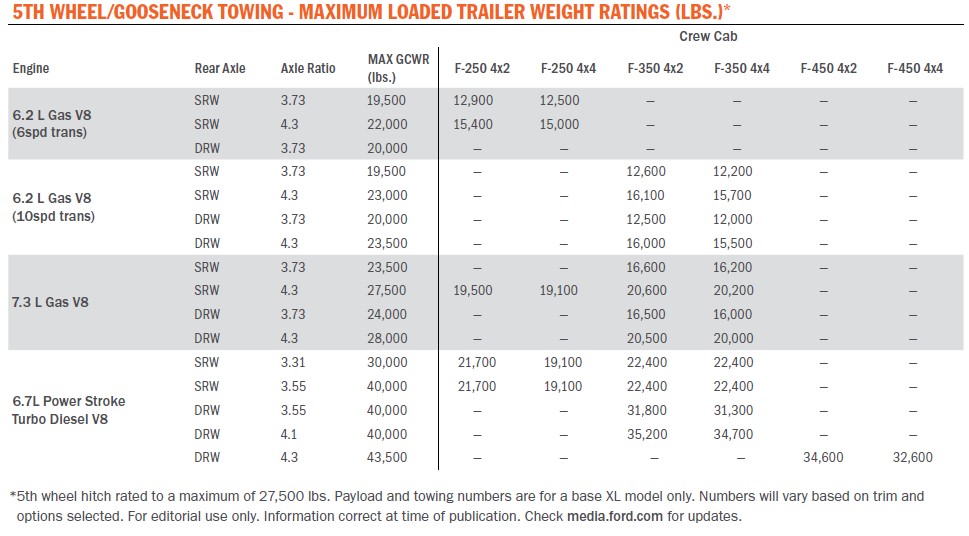
Looking at the block for the 6.7L Power Stroke Diesel, we have a few options. We will only look at the top two rows, as those are the SRW only; but do we have the 3.31 or the 3.55 axle ratio? The answer lies again in the “optional equipment” section of the window sticker
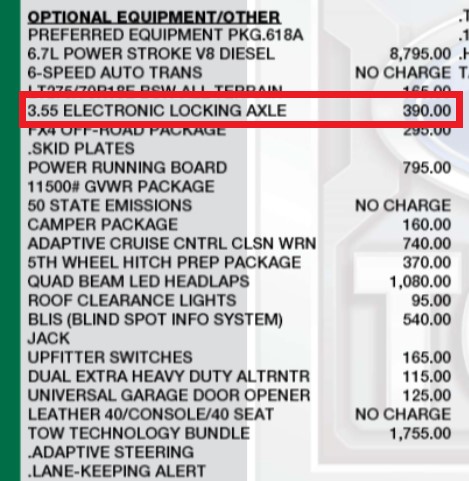
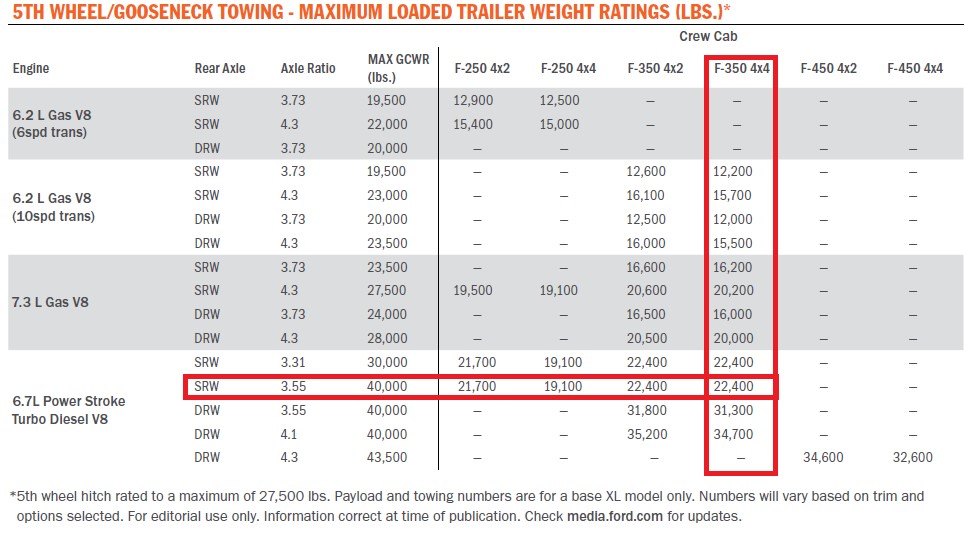
Our maximum weight rating for Gooseneck/5th Wheel in our example F350 SRW 4×4, 11,500# package with 3.55 axle ratio is 22,400 pounds. Although this is an incredible amount of weight to be able to tow, this is about 13,000 pounds from the advertising claim of 37,000 pounds. If you were to look deeper into the specs, you would see that to get the advertised 37,000 pounds, you would need to get a single cab, F450 DRW with the 4.3 axle ratio. This does not mean it’s a poor performer, quite the contrary, but now you are informed on your vehicle’s limits and are safer because of it.
GCWR – Gross Combined Weight Rating
This is also listed on the spec sheet under the towing capacity, once you have found the correct row – for this specific set-up it is 40,000 pounds. This means that Truck plus (+) equipment inside truck/bed plus (+) trailer must be less then GCWR (40,000 pounds).
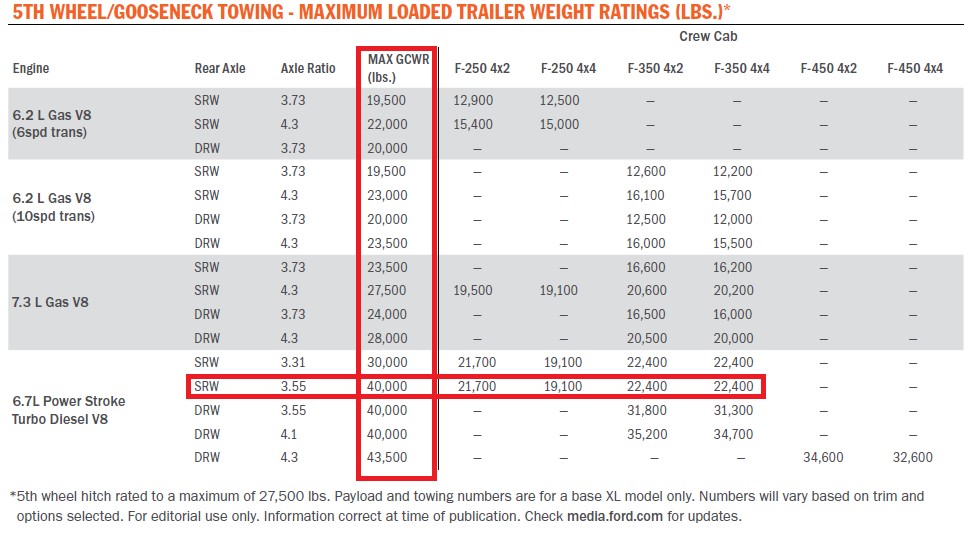
Where do I go from here? What trailer can I buy?
This is a great question! Now that you know about the specs within a truck, we can talk specifics to the trailer. That, however, is a post for another day. Look for our next post on how to figure the type of trailer you can safely tow!
